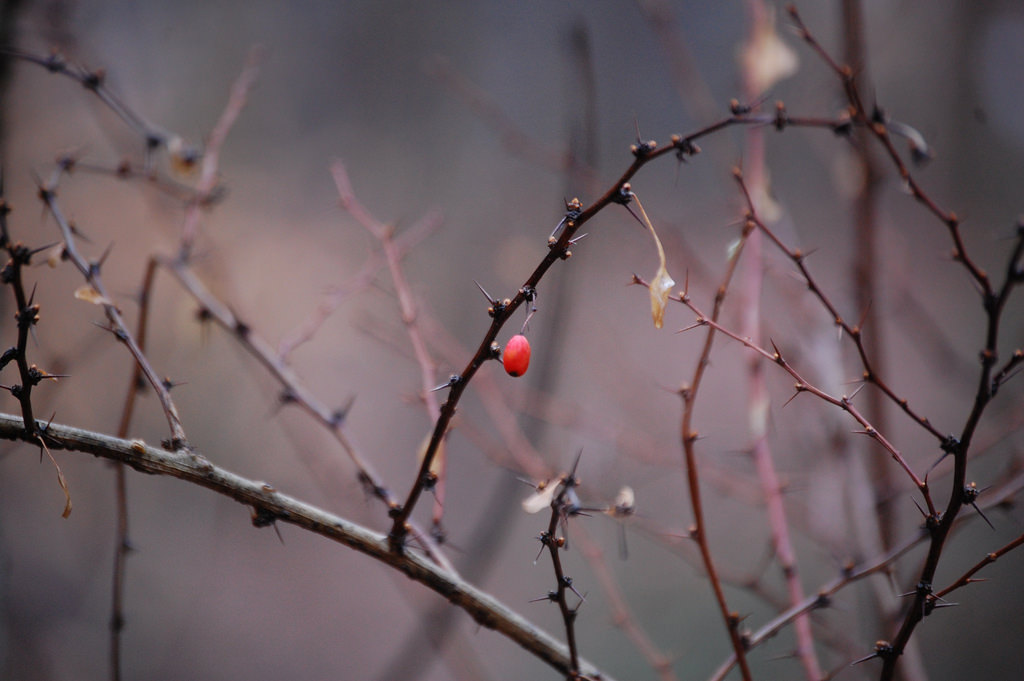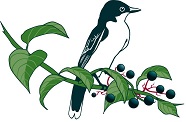Some gardening projects, like removing invasive plants are easier to do in the winter. Winter is a great time to tackle invasive plants because leaves have fallen making access to certain “wild” areas easier and making the plants themselves easier to handle. Thorny, invasive plants are also much easier to deal with when wearing long sleeves or a jacket.
Invasive plants are foreign plants that can overrun an area, choke out native plants and limit diversity. At the top of the list of invasive plants to tackle are Multiflora Rose, Oriental Bittersweet, Burning Bush, Japanese Barberry, and English Ivy. These foreign sounding names warn you that these plants can be problematic in our area.
Multiflora Rose
Easily identify multiflora rose in winter by its distinctive green, thorny stems and arching branches. Grab a thick pair of gloves and some loppers to tackle very large areas of rose. Cut into a thicket of rose, until you get to the base of a plant, and then pull it out by the roots. It is easy to pull out all but the very largest shrubs, and these can be removed later with a shovel and hand saw. Cut the roses into large pieces, and pile them up in one area. They break down fairly quickly, and within several months, the pile will be much smaller.
Oriental Bittersweet
Oriental Bittersweet is a vine with red fruit surrounded by yellow capsules. It can quickly cover trees and shrubs, inhibit their growth and photosynthesis, and topple them with its weight.

Manage Oriental Bittersweet like Multiflora Rose. Cut unwanted vines close to the base and pull out the root to ensure the plant doesn’t grow back. Remove the sections of hanging vine that are within reach. And leave the remaining vines that are out of reach to dry out and fall from the trees over time.
Burning Bush
Burning Bush, or Winged Euonymus is an ornamental shrub that is planted for its red fall color. However, burning bush is considered invasive in most of the Northeast. Identify it in winter by its winged stems.

Remove Burning bush by digging it up by the roots using a shovel or pulling it out with a root wrench. Another option is to cut it off at the base and paint the cut stem with a small amount of herbicide. Contact GreenWeaver’s Pennsylvania Certified Pesticide Applicators if you have concerns about safely using pesticides.
Japanese Barberry

Like Burning Bush, Japanese Barberry is a shrub that has been used for ornamental purposes but has become invasive. Identify it by its thorns and berries that may persist in winter.
Remove Barberry like you would Burning Bush, but pay special attention to the thorns!
English Ivy
Winter is also a great time to remove groundcovers such as English Ivy. Many of these plants remain evergreen, so they are easy to spot when other plants have gone dormant. Grab a sturdy shovel to dig these out by the roots. Start at one end and methodically shave off the top few inches of soil containing the roots. Roll the mat of groundcover up like you would a carpet. Shake out the soil as you go to minimize weight.
Maintenance
After you tackle invasive plants, police areas where you removed them in the spring to stop any re-sprouting that is certain to occur. Do this routinely and each subsequent time will become easier to manage.
Filling Spaces
Also, it is important to fill these newly cleared spots with plants that you like in order to keep the invaders from moving back in. We recommend a selection of native plants to provide beauty, health, and habitat.
For the best success, choose plants that are found in a similar site in nature as the right plant in the right place will provide you with years of enjoyment. Work with a landscape designer that is familiar with native plants if you need advice. And of course, you can always contact us if you need help.


